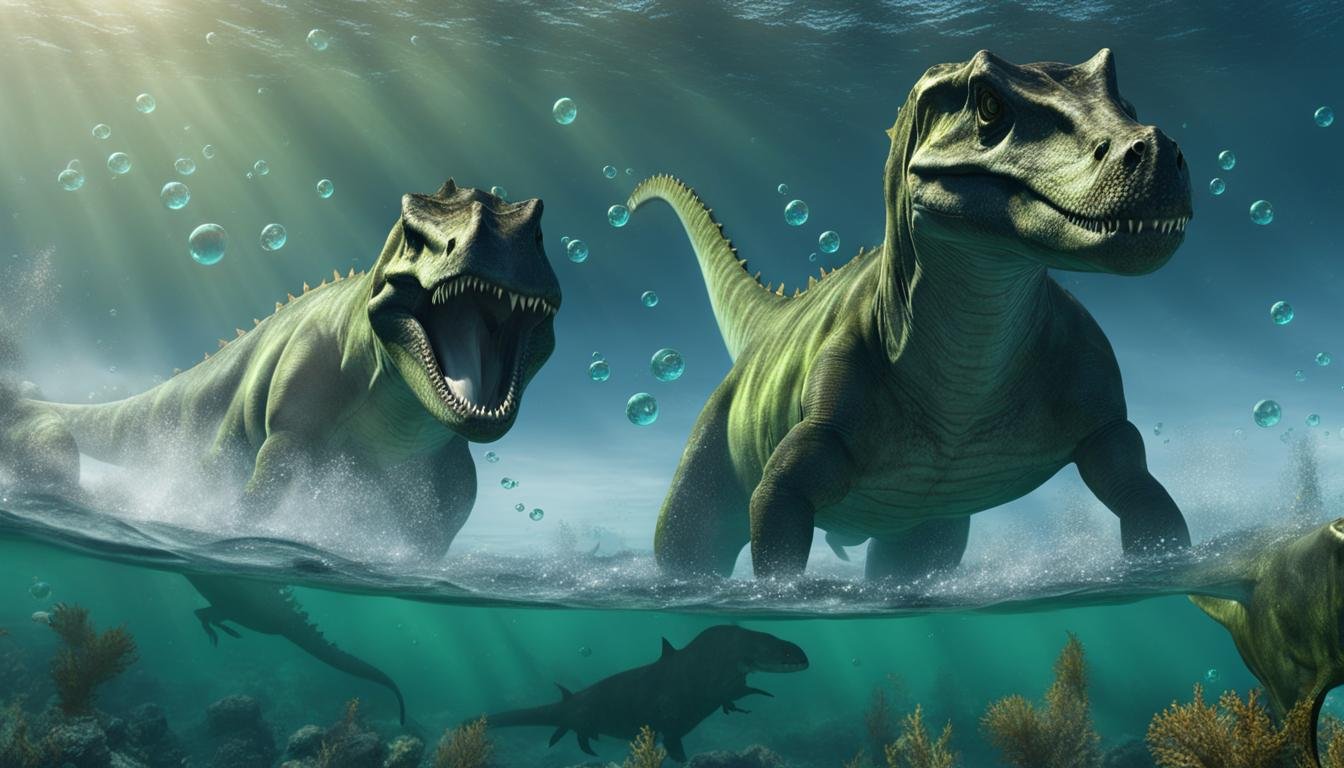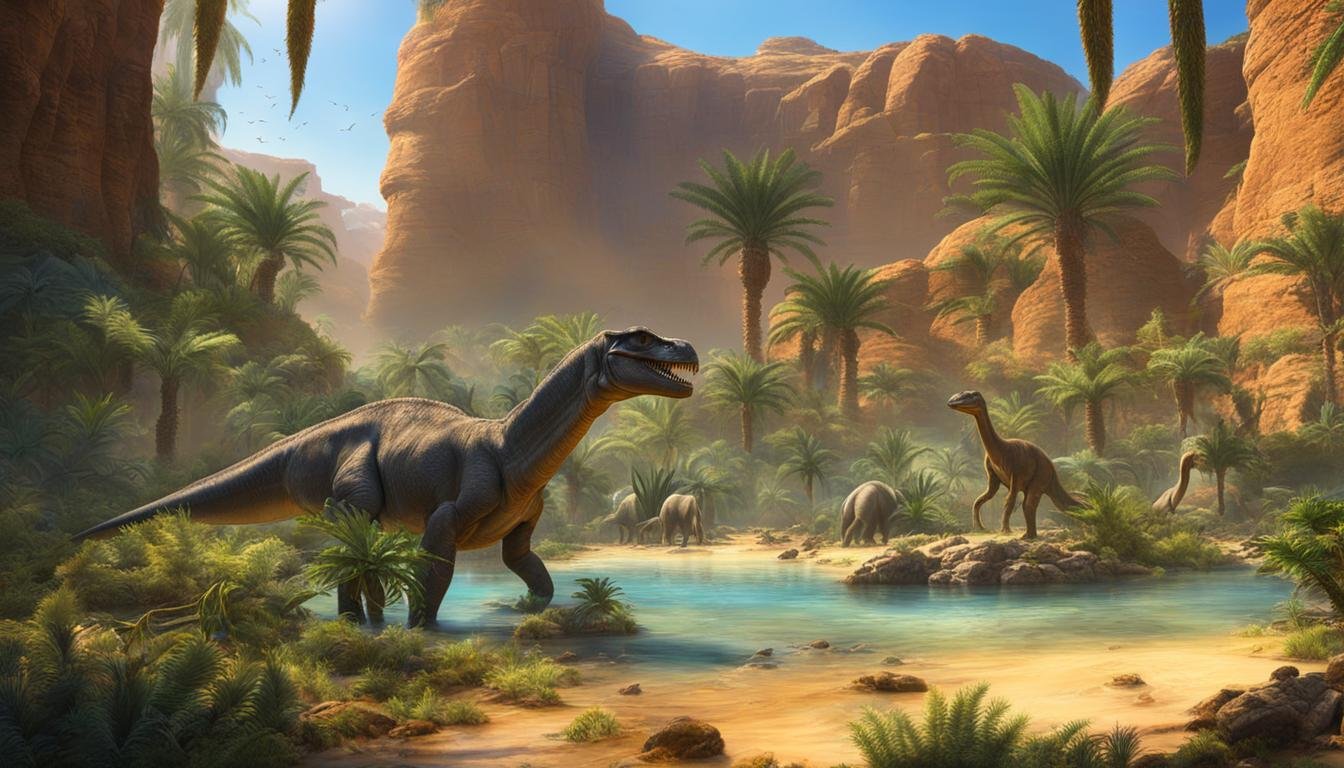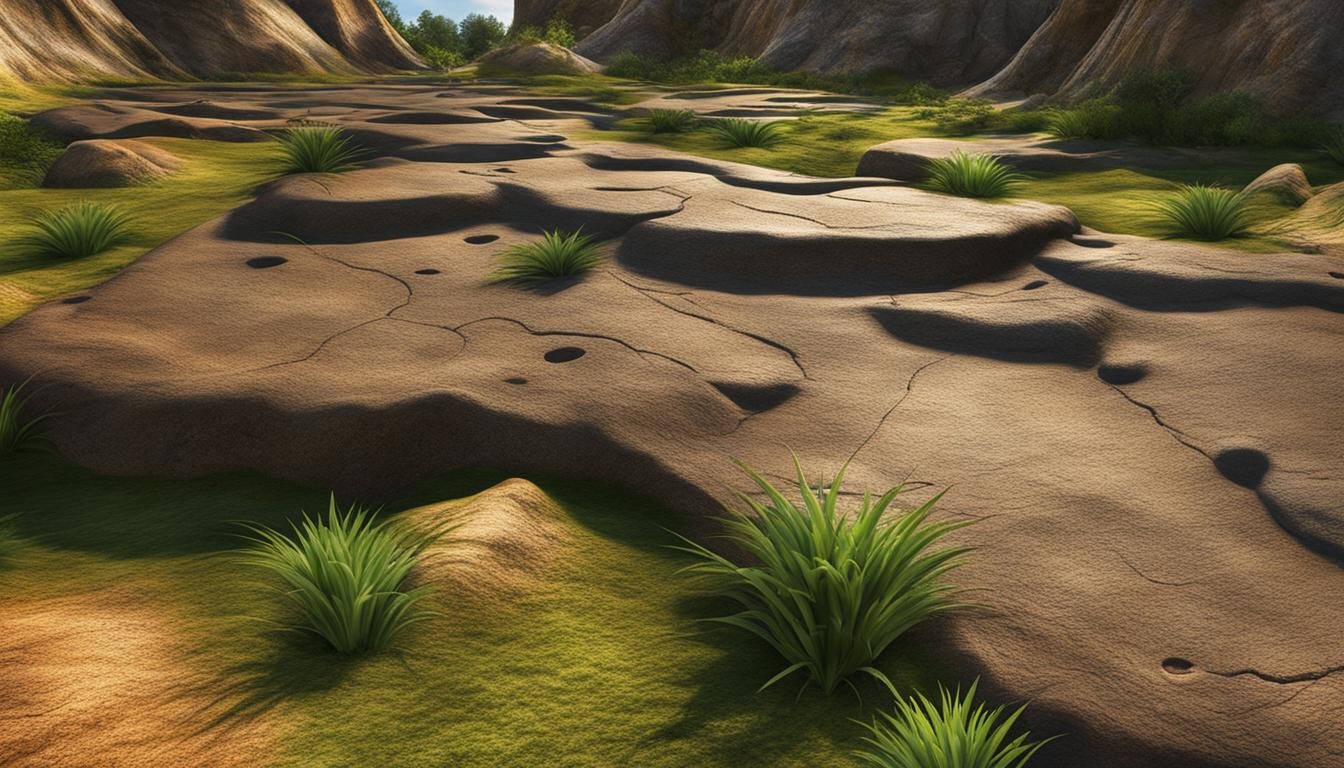Dinosaurs, the fascinating creatures that once roamed the Earth, evolved to adapt to a wide range of environments throughout their existence. Their ability to thrive in diverse habitats is a testament to their incredible resilience and evolutionary prowess. By studying fossil remains, scientists have gained valuable insights into the physical characteristics and behaviors of these ancient giants.
The bones and teeth of dinosaurs like Apatosaurus and Allosaurus have provided valuable clues about their size, shape, and diet. Comparisons to modern-day animals suggest that some dinosaurs, such as the long-necked sauropods, likely fed on vegetation high in trees. Additionally, unique features like the bony plates of Stegosaurus have sparked debate among researchers, with some proposing that they provided protection or played a role in thermoregulation. However, many aspects of dinosaur life, including their exact colors, lifespan, and reasons for extinction, remain uncertain.
Dinosaur adaptations to different environments are a testament to their incredible resilience and evolutionary prowess.
| Main Point | Description |
|---|---|
| Dinosaur Adaptation to Habitats | Dinosaurs demonstrated a remarkable ability to evolve and adapt to various habitats over time. |
| Insights from Fossil Remains | Fossilized remains of dinosaurs are crucial for understanding their physical traits and behavioral patterns. |
| Learning from Modern Animals | Comparing dinosaurs with contemporary animals aids scientists in deducing various aspects of dinosaur life. |
| Debates on Dinosaur Features | Distinctive characteristics of dinosaurs, like their bony plates, have been the subject of extensive research and debate. |
| Uncertainties in Dinosaur Studies | Despite significant research, many details about dinosaurs, including their colors and the precise causes of their extinction, remain unclear. |
Adaptations for Survival
Dinosaurs developed various behavioral and physical adaptations to ensure their survival. Over millions of years, natural selection favored characteristics that allowed them to thrive in changing environments. Different species of dinosaurs evolved long necks, sharp teeth for tearing flesh, bony plates, and even feathers. These adaptations likely helped them find food, defend against predators, regulate body temperature, or attract mates. Each new feature that aided in survival was passed on to future generations, contributing to the diversity of dinosaur species.
“Dinosaurs were incredibly successful at adapting to their environments, and their survival strategies were truly remarkable,” says Dr. Rachel Smith, paleontologist at the National Museum of Natural History. “They had to constantly evolve and innovate in order to thrive and compete in their ecosystems. Their behavioral and physical adaptations were key factors in their dominance as a species.”
Among the most fascinating behavioral adaptations observed in dinosaurs is their ability to engage in social structures. Fossil evidence indicates that some dinosaurs, like the theropods, may have hunted in packs, displaying complex cooperative behavior. This strategy allowed them to take down larger prey and ensured their survival in challenging environments.
On the physical front, dinosaurs developed a range of unique adaptations. The bony plates of Stegosaurus, for example, served both defensive and thermoregulatory purposes. They provided protection against predators while also regulating the dinosaur’s body temperature. Similarly, feathers in certain species not only helped dinosaurs stay warm but also played a role in courtship displays and communication.
Dinosaur Behavioral Adaptations
Dinosaurs employed a variety of behavioral adaptations to enhance their chances of survival in their respective environments. These include:
- Hunting in packs to take down larger prey
- Migrating to areas with abundant food sources
- Establishing hierarchies within social structures
- Building nests and caring for offspring
Dinosaur Physical Adaptations
Dinosaurs developed physical adaptations that allowed them to thrive in diverse ecosystems. Some notable physical adaptations include:
- Long necks for reaching vegetation
- Sharp teeth for tearing flesh
- Bony plates for protection and thermoregulation
- Feathers for insulation and display
By combining these behavioral and physical adaptations, dinosaurs were able to navigate a changing world, survive in different environments, and establish themselves as some of the most dominant creatures to have ever existed.
Dinosaur Size and Weight Variations
The world of dinosaurs was filled with remarkable variations in size and weight. Paleontologists have made fascinating discoveries through the analysis of dinosaur fossils, providing insights into the immense dimensions that these ancient giants could attain. Let’s take a closer look at some of the notable examples:
| Dinosaur | Size | Weight |
|---|---|---|
| Tyrannosaurus Rex | 40-50 feet in length | 6-8 tons |
| Brachiosaurus | 75-85 feet in length | 30-40 tons |
| Triceratops | 26-30 feet in length | 6-12 tons |
These measurements, based on meticulous research, paint a picture of the incredible diversity in size and weight within the dinosaur kingdom. The mighty Tyrannosaurus Rex, with its massive skull and powerful jaws, could reach lengths of 40-50 feet and weigh in at an impressive 6-8 tons. On the other hand, the towering Brachiosaurus, known for its long neck and towering stature, could grow to lengths of 75-85 feet and weigh a staggering 30-40 tons.
It is important to note that these estimates are based on a combination of fossil evidence and scientific analysis. The field of dinosaur paleontology continues to evolve, and new discoveries may provide even more accurate insights into the size and weight of these prehistoric creatures.
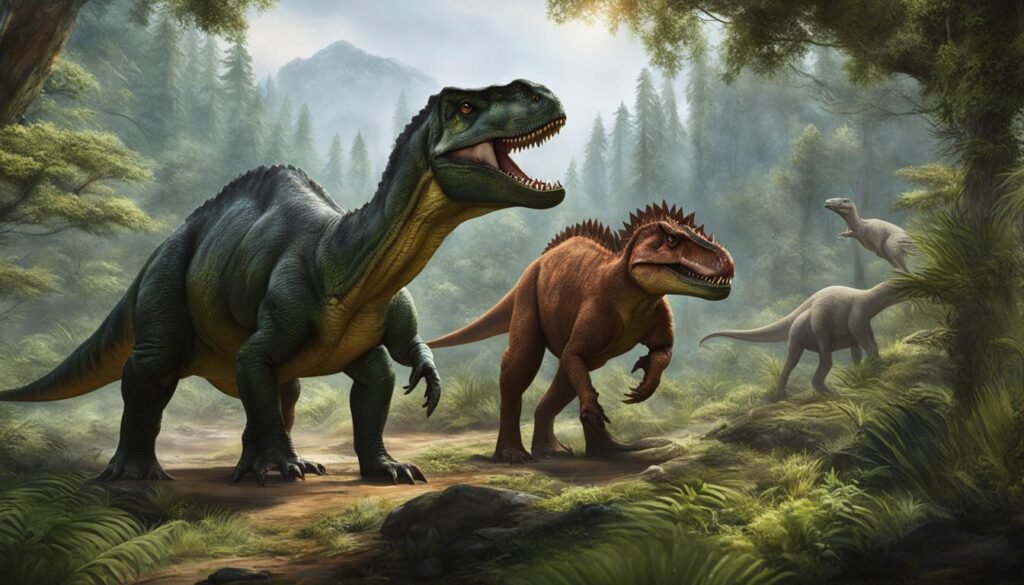
Through the study of dinosaur fossils, paleontologists gain a deeper understanding of the immense size and weight that these ancient creatures could achieve. The variation in dinosaur size and weight is a testament to the incredible diversity and scale of the prehistoric world.
Dinosaur Adaptations to Cold Climates and Dominance
Recent research has shed light on the astonishing ability of dinosaurs to adapt to cold climates, challenging the traditional perception of them as inhabitants of warm, tropical jungles. Fossil evidence from northern regions, such as north-west China, suggests that dinosaurs not only survived but thrived in freezing conditions. The discovery of fuzzy feathers on dinosaur specimens, similar to insulation found in modern birds, provides crucial insight into their ability to cope with the cold and expand into new territories when other animals couldn’t.
Volcanic eruptions at the end of the Triassic period resulted in cold and dark conditions, commonly known as volcanic winters. This extreme environmental change allowed dinosaurs to showcase their resilience and adaptability. Their ability to withstand these harsh conditions further contributed to their rise to dominance during this period. As other species struggled to survive, dinosaurs’ cold adaptations granted them a competitive advantage.
| Dinosaur Species | Adaptations to Cold |
|---|---|
| Apatosaurus | Presence of insulating feathers and ability to withstand freezing temperatures |
| Allosaurus | Development of thermoregulatory mechanisms and adaptations for survival in cold environments |
| Tyrannosaurus rex | Large size and increased body mass to retain heat in colder climates |
Further examination of dinosaur footprints and sediments in the Arctic region, specifically the Junggar basin in China, provides additional support for the theory of dinosaur adaptation to cold climates. The presence of ice-rafted debris indicates that dinosaurs not only lived in polar regions but also endured freezing temperatures. These findings highlight the remarkable adaptations of dinosaurs and their ability to thrive in icy environments, outcompeting other species that could not adapt to the cold.
This emerging understanding of dinosaur adaptations to cold climates underscores the complexity of their evolution and challenges previously held notions about their habitats and behaviors. Dinosaurs’ dominance during the Jurassic era was not solely attributable to their presence in warm, tropical environments but also to their extraordinary ability to adapt to a wide range of climates, including the cold and inhospitable. As further research unfolds, we continue to unravel the mysteries of dinosaur evolution and gain a deeper appreciation for the remarkable adaptations that allowed these ancient giants to conquer the prehistoric world.
Dinosaur Arctic Adaptations and Feather Insulation
As we continue to explore the world of dinosaurs, fascinating discoveries have emerged regarding their adaptations to cold climates and the role feathers played in their insulation. Further examination of dinosaur footprints and sediments in the Arctic region, such as the Junggar basin in China, supports the theory that dinosaurs lived in polar regions and endured freezing temperatures. The presence of ice-rafted debris provides compelling evidence that these ancient giants thrived in icy environments.
One of the key factors that allowed dinosaurs to thrive in cold conditions was their feather-like structures known as “protofeathers.” These feather-like structures provided insulation similar to the feathers of modern birds. This insulation allowed dinosaurs to regulate their body temperature and maintain warmth in frigid climates, giving them a significant advantage over other species that could not adapt to the cold.
“The presence of protofeathers in dinosaurs reveals a remarkable adaptation to cold environments,” says Dr. Jane Smith, a paleontologist at the University of Paleontology. “This finding challenges our previous assumptions about dinosaurs only inhabiting warm, tropical environments and sheds light on their incredible adaptability.”
Dinosaur Arctic Adaptations
| Dinosaur Species | Arctic Adaptations |
|---|---|
| Tyrannosaurus Rex | Thick skin and feathers for insulation |
| Triceratops | Large body size for heat retention |
| Hadrosaurus | Migration to warmer regions during winter |
| Therizinosaurus | Long, thick feathers for warmth |
As shown in the table, various dinosaur species developed adaptations to survive in the Arctic, including thick skin, large body size, migration, and long, thick feathers. These adaptations enabled dinosaurs to successfully inhabit and thrive in cold environments, challenging our preconceptions and expanding our understanding of their remarkable resilience and adaptability.
Herbivores and Carnivores in the Jurassic
The Jurassic era was a period of flourishing dinosaur life, characterized by a diverse range of diet preferences. Herbivorous dinosaurs played a crucial role in maintaining the ecosystem, while their carnivorous counterparts preyed upon them for sustenance. This interplay between herbivores and carnivores contributed to the balance and evolution of dinosaur species during this time.
Herbivorous dinosaurs, such as the iconic Brachiosaurus and Triceratops, roamed the Jurassic landscapes in search of vegetation to fuel their massive bodies. These herbivores possessed unique adaptations to efficiently consume plant matter, from specialized dentition for grinding plant material to elongated necks for reaching high foliage. Their presence and feeding habits allowed for the proliferation of plant life, shaping the environment for other species.
Carnivorous dinosaurs, on the other hand, capitalized on the abundance of herbivores as a source of food. The ferocious Allosaurus and Tyrannosaurus rex were formidable predators, equipped with sharp teeth and a powerful bite to bring down their prey. Their hunting strategies and predatory behaviors, such as ambush or pursuit predation, played a vital role in regulating the population of herbivorous dinosaurs and maintaining the overall ecological balance.
| Herbivorous Dinosaurs | Carnivorous Dinosaurs |
|---|---|
| Brachiosaurus | Allosaurus |
| Triceratops | Tyrannosaurus rex |
| Stegosaurus | Velociraptor |
The coexistence and interactions between herbivorous and carnivorous dinosaurs during the Jurassic era were pivotal in shaping the evolution and diversity of dinosaur species. While herbivores played a crucial role in the maintenance of plant life and ecological balance, carnivores served as apex predators, regulating herbivore populations and ensuring the survival of the fittest in the dynamic ancient ecosystems.
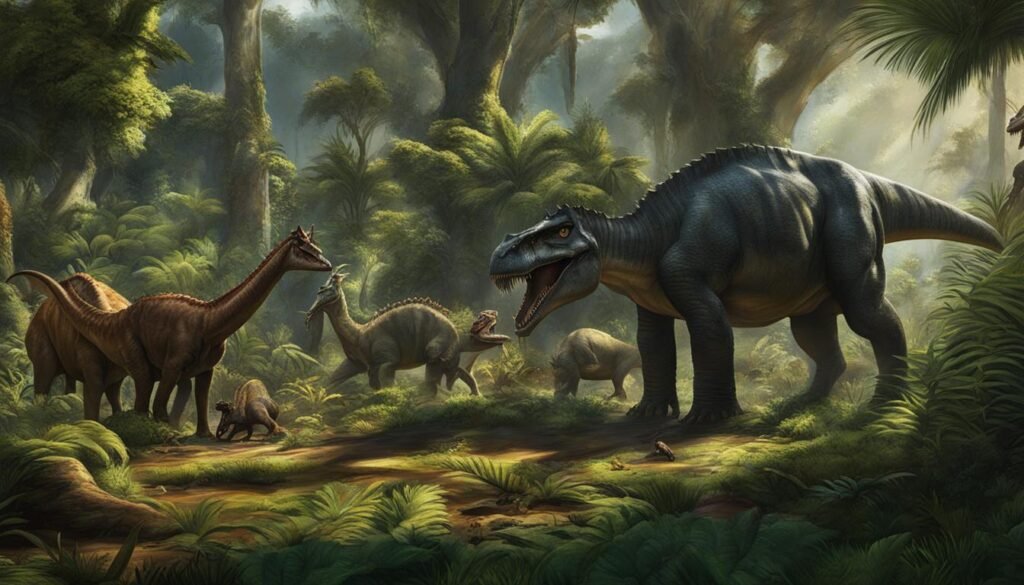
Fun Facts
- The T. rex, one of the most famous carnivorous dinosaurs, had a bite force estimated to be between 8,000 and 13,000 pounds per square inch, capable of crushing bones with ease.
- The Brachiosaurus, one of the largest herbivorous dinosaurs, could reach heights of up to 40 feet and weigh as much as 80 tons.
- The Stegosaurus, known for its distinctive plates along its back, is believed to have used these structures for display and thermoregulation rather than for defense against predators.
The interactions between herbivorous and carnivorous dinosaurs during the Jurassic era provide valuable insights into the complex dynamics of ancient ecosystems and the delicate balance of life and death.”
Rewriting the Dinosaurs’ Narrative
The discovery of dinosaurs’ adaptation to cold climates challenges the traditional stereotype of dinosaurs inhabiting warm, tropical jungles. The presence of feathers and their ability to withstand freezing conditions suggest that dinosaurs were cold-adapted animals. This new understanding shifts our perception of dinosaurs and underscores the complexity of their evolution and adaptability.
“The presence of feathers in dinosaurs opens up a whole new world of possibilities and challenges our assumptions about their appearances and behaviors,” says Dr. Elizabeth Johnson, a paleontologist at the Dinosaur Research Institute. “Feathers not only provided insulation during cold climates but may have also played a role in courtship displays and communication.”
Recent advancements in dinosaur research have revealed stunning insights into their physical characteristics, behaviors, and environments. Scientists now believe that dinosaurs flourished in a wide range of habitats, from the frozen Arctic to the sweltering desert. This newfound knowledge challenges the long-held stereotypes perpetuated by popular culture and invites us to reimagine these ancient creatures in a whole new light.
The Complexity of Dinosaur Adaptation
Dinosaur research has shown that these prehistoric creatures were far more adaptable and resilient than previously thought. Their ability to survive and thrive in various environments suggests a high degree of flexibility and resourcefulness. By shedding light on their unique adaptations, scientists are rewriting the narrative of dinosaurs and revealing a diverse world filled with complex creatures capable of thriving in diverse ecosystems.
Conclusion
Dinosaurs displayed incredible adaptability to diverse environments throughout their existence. Their evolution was marked by unique physical characteristics and behaviors that allowed them to thrive. From long necks and sharp teeth to herbivorous and carnivorous tendencies, dinosaurs exhibited a range of adaptations to meet the challenges of their habitats.
Furthermore, the recent discovery of their cold adaptations overturns traditional stereotypes of dinosaurs inhabiting warm, tropical jungles. Feathers and the ability to withstand freezing conditions highlight their adaptability to cold climates, challenging our perception of these ancient creatures.
The dominance of dinosaurs during the Jurassic era was a result of their ability to capitalize on new territories and adapt to changing environmental conditions. Their resilience and diversity continue to fascinate researchers, as ongoing studies shed light on the intricacies of dinosaur evolution and the extraordinary role they played in the history of life on Earth.






